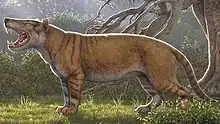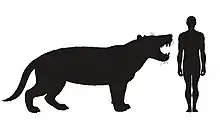Simbakubwa
Simbakubwa ("great lion") is an extinct genus of hyainailourid hyaenodonts from paraphyletic subfamily Hyainailourinae that lived in Kenya during the early Miocene.[1]
| Simbakubwa Temporal range: early Miocene | |
|---|---|
 | |
| reconstruction of Simbakubwa kutokaafrika | |
 | |
| size comparison to human | |
| Scientific classification | |
| Domain: | Eukaryota |
| Kingdom: | Animalia |
| Phylum: | Chordata |
| Class: | Mammalia |
| Order: | †Hyaenodonta |
| Superfamily: | †Hyainailouroidea |
| Family: | †Hyainailouridae |
| Subfamily: | †Hyainailourinae |
| Genus: | †Simbakubwa Borths & Stevens, 2019 |
| Type species | |
| †Simbakubwa kutokaafrika Borths & Stevens, 2019 | |
Discovery and Etymology
The fossils of Simbakubwa were first discovered by rural Kenyans at Meswa Bridge, Western Kenya. Thereafter, Matthew Borths and Nancy Stevens published the findings after examining the fossils which had been stored at the Nairobi National Museum in Kenya for decades.[2] The type specimen consists of a mandible from the lower jaw, a right upper maxilla and some postcranial remains. The light wear patterns on the dentition indicate that the holotype specimen was a young adult at the time of its death.
The name of this genus comes from the Swahili language, meaning "great lion". The species name Simbakubwa kutokaafrika means "great lion of Africa”.
Description
Different regression models produce a wide range of body mass estimates for Simbakubwa kutokaafrika: from a low estimate of 280 kg (620 lb), based on an equation derived from the m3 length of various large carnivorans, comparable to the largest lions, to an upper estimate possibly reaching up to 1,500 kg (3,300 lb), an equation based on the m3 length of felids, which would surpass the modern polar bear in size.[1] However, hyainailourids possessed proportionally very large heads in comparison to their body, and postcranial remains indicate that the similar sized Hyainailouros was about the size of a tiger, whereas the larger Megistotherium has been estimated to have reached a maximum weight of 500 kg.[3]
The study of the postcranial remains indicates Simbakubwa was possessed of a semi-digitigrade walking stance.[1]
Paleoecology
Simbakubwa, like other hyainailourids, probably was a specialist hunter and scavenger that preyed on creatures such as rhinoceroses and early proboscideans. It may have been somewhat less specialized in crushing bone than its later relatives such as Hyainailouros. However, like Hyainailouros, Simbakubwa possessed lingually rotating carnassial blades, ensuring a constant shearing edge throughout its life.[1]
Phylogeny
The phylogenetic relationships of genus Simbakubwa are shown in the following cladogram:[4][1][5][6][7]
| †Hyaenodonta |
|
|||||||||||||||||||||||||||||||||||||||||||||||||||||||||||||||||||||||||||||||||||||||||||||||||||||||||||||||||||||||||||||||||||||||||||||||||||||||||||||||||||||||||||||||||||||||||||||||||||||||||||||||||||||||||||||||||||||||||||||||||||||||||||||||||
See also
References
- Matthew R. Borths; Nancy J. Stevens (2019). "Simbakubwa kutokaafrika, gen. et sp. nov. (Hyainailourinae, Hyaenodonta, 'Creodonta,' Mammalia), a gigantic carnivore from the earliest Miocene of Kenya". Journal of Vertebrate Paleontology. 39 (1): e1570222. Bibcode:2019JVPal..39E0222B. doi:10.1080/02724634.2019.1570222. S2CID 145972918.
- Zuckerman, C. (18 April 2019). "This new species of ancient carnivore was bigger than a polar bear". National Geographic. Retrieved 2019-04-18.
- Sorkin, Boris (2008). "A biomechanical constraint on body mass in terrestrial mammalian predators". Lethaia. 41 (4): 333–347. doi:10.1111/j.1502-3931.2007.00091.x.
- Borths, Matthew R.; Stevens, Nancy J. (2017). "Deciduous dentition and dental eruption of Hyainailouroidea (Hyaenodonta, "Creodonta," Placentalia, Mammalia)". Palaeontologia Electronica. 20 (3): 55A. doi:10.26879/776.
- Floréal Solé; Bernard Marandat; Fabrice Lihoreau (2020). "The hyaenodonts (Mammalia) from the French locality of Aumelas (Hérault), with possible new representatives from the late Ypresian". Geodiversitas. 42 (13): 185–214. doi:10.5252/geodiversitas2020v42a13. S2CID 219585388.
- Solé, F.; Morlo, M.; Schaal, T.; Lehmann, T. (2021). "New hyaenodonts (Mammalia) from the late Ypresian locality of Prémontré (France) support a radiation of the hyaenodonts in Europe already at the end of the early Eocene". Geobios. 66–67: 119–141. Bibcode:2021Geobi..66..119S. doi:10.1016/j.geobios.2021.02.004. S2CID 234848856.
- Averianov, Alexander; Obraztsova, Ekaterina; Danilov, Igor; Jin, Jian-Hua (2023). "A new hypercarnivorous hyaenodont from the Eocene of South China". Frontiers in Ecology and Evolution. 11. doi:10.3389/fevo.2023.1076819. ISSN 2296-701X.